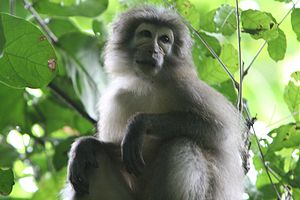Sanje-Mangabe
| Sanje-Mangabe | ||||||||||||
|---|---|---|---|---|---|---|---|---|---|---|---|---|

Sanje mangabe ( Cercocebus sanjei ) |
||||||||||||
| Systematics | ||||||||||||
|
||||||||||||
| Scientific name | ||||||||||||
| Cercocebus sanjei | ||||||||||||
| Mittermeier , 1986 |
The Sanje mangabe ( Cercocebus sanjei ) is a species of primate from the family of vervet monkeys (Cercopithecidae). It is endemic to Tanzania . It used to be and is occasionally still today regarded as a subspecies of the hood indication ( Cercocebus galeritus ).
features
Sanje-Mangaben reach a head body length of 50 to 65 centimeters, to which a tail about 55 to 60 centimeters long comes. Their weight varies between approx. 10 (males) and 5 to 6 (females) kilograms. Sanje mangabs have a gray coat , hands and feet are darker, the belly is lighter, almost whitish. The hairless skin of the face is pink or gray, like all members of its genus, Sanje Mangaben have whitish eyelids. The tail is relatively long and white at the tip.
Habitat and way of life
These primates are found only on some eastern slopes of the Udzungwa Mountains and in forests around the Mwanihana in southern Tanzania, where they inhabit forests on river banks at an altitude of 400 to 1600 meters. They spend more than 50% of their time on the ground.
They are diurnal and live in groups. Their diet consists of fruits, seeds, nuts and small animals. More than 50% of the diet consists of fruits, around a quarter of seeds and around 10% of insects and other invertebrates. Leaves, flowers, bark, mushrooms, lichens and plant saps make up only a small part of their diet. The small animals that are eaten include insects, millipedes, snails, frogs, freshwater and land crabs, and chameleons .
Sanje mangaben reproduce all year round. At the time of their fertility, females develop noticeable sexual swellings. After a gestation period of about 173 days, a single young is born.
Danger
Sanje mangaben are among the most threatened primates in Africa. The total population is estimated to be less than 1,300 animals living in two populations 85 kilometers apart. The main threat is the destruction of their already small habitat, plus hunting. The larger of the two populations, however, lives in a protected area, the Udzungwa Mountains National Park . The IUCN lists the species as "critically endangered" ( endangered ).
literature
- Thomas Geissmann : Comparative Primatology. Springer-Verlag, Berlin et al. 2003, ISBN 3-540-43645-6 .
- Don E. Wilson, DeeAnn M. Reeder (Eds.): Mammal Species of the World. A taxonomic and geographic Reference. Johns Hopkins University Press, Baltimore MD 2005, ISBN 0-8018-8221-4 .
Individual evidence
- ↑ a b c d e Elizabeth L. Gadsby, Colin P. Groves, Aoife Healy, K. Praveen Karanth, Sanjay Molur, Tilo Nadler, Matthew C. Richardson, Erin P. Riley, Anthony B. Rylands, Lori K. Sheeran, Nelson Ting, Janette Wallis, Siân S. Waters & Danielle J. Whittaker: Family Cercopithecidae (Old World Monkeys). Page 652 in Russell A. Mittermeier , Anthony B. Rylands & Don E. Wilson : Handbook of the Mammals of the World: - Volume 3. Primates. Lynx Editions, 2013 ISBN 978-8496553897
- ↑ Cercocebus sanjei in the endangered Red List species the IUCN 2011. Posted by: C. Ehardt, T. M. Butynski, T. T. Struhsaker, 2008. Accessed July 30, 2011th
